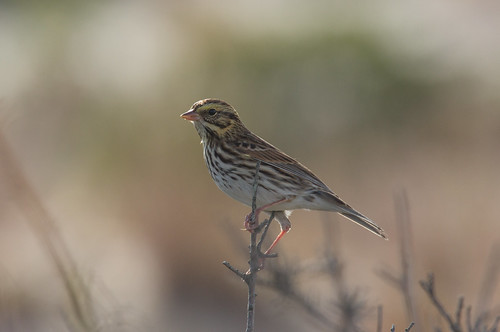 |
| Fox Sparrow |
For a brief window during spring migration, from the last week of April through the middle of May, my backyard may be fluttering and crawling with sparrows. House Sparrows aren’t part of my neighborhood’s avifauna and, oddly enough, aren’t related to the native sparrows of North America. But over the years, I’ve seen a dozen different species of native sparrows in my own backyard—a baker’s dozen if you count the Eastern Towhee, which really is just an oversized sparrow.
 |
| Eastern Towhee: Yes, this is a sparrow! |
A lot of birders are intimidated by sparrow identification—they’re all LBJs, or “Little Brown Jobs,” aren’t they? But when you pay attention, recognizing most is pretty straightforward, and knowing which have similar markings gives you a heads-up to focus on noticeable differences between alternatives.
 |
| Dark-eyed Junco, adult male |
Despite being entirely and uniquely unstreaked among sparrows, Dark-eyed Juncos are not only related to North American sparrows—they are sparrows. And they’re virtually always the first to arrive at our feeders each year. A flock of about a dozen spent this entire winter on Peabody Street. I saw my first for 2022 on January 1, and then virtually every day after that until April, when the wintering flock dissipated, those birds presumably moving on toward their nesting range. By the third week of April, newly arriving juncos filled the vacuum, and by the afternoon of April 26, I had over 200!
Identifying adult juncos is straightforward, and even young females in our backyards are unstreaked with the distinctive junconian* solid pink bill, white tummy, and white outer tail feathers. Baby juncos have noticeable streaking on their backs and undersides like other sparrows, important to be aware of when birding in Northland woods in summer where some juncos breed, but it’s never an issue with juncos visiting our feeders in spring, and even by the time young ones venture from their parents’ territory in late summer, they’ve molted into more standard, unstreaked junco plumage.
*Junconian: Quality shared by juncos. Etymology: From junco. Coined by Laura Erickson on April 28, 2022 for this very blog post.
 | |
|
This year, my first Fox Sparrow arrived on April 11, and I’ve seen a smattering of them every day since—from 1 to 20—but they’ll soon be moving on. Usually I have to wait until September or October to see them after spring migration, but this year Russ and I may find some up in Alaska in June. I’m partial to the eastern subspecies, which is the rustiest and has the prettiest markings, but no matter which subspecies it belongs to, any Fox Sparrow is plenty good enough for me.
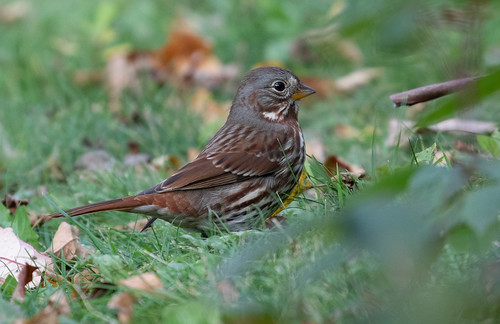 |
| Fox Sparrow |
Like most sparrows, Fox Sparrows have streaked backs, but they also have a prominently streaked underside, the streaks coalescing in a prominent central spot. Three other adult sparrows sometimes seen in Northland backyards—Song, Savannah, and Lincoln’s—share that. The Fox Sparrow is by far the largest and rustiest of the four, and its conspicuous rusty tail differentiates it from all other sparrows—flying away, it would only be mistaken for a Hermit Thrush.
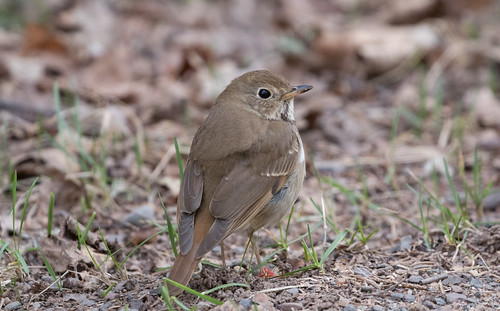 |
| The Hermit Thrush's rusty tail is conspicuous when it flies off, but otherwise it doesn't look at all sparrow-like. |
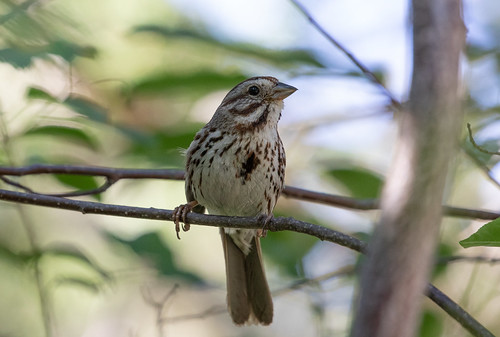 Song Sparrow |
 |
| Song Sparrow |
The Song Sparrow shares the Fox Sparrow’s streaked underside with that central spot, but the Song Sparrow is much smaller and gray/brown, not rusty. Song Sparrows arrive early, too—my first this year showed up on April 15.
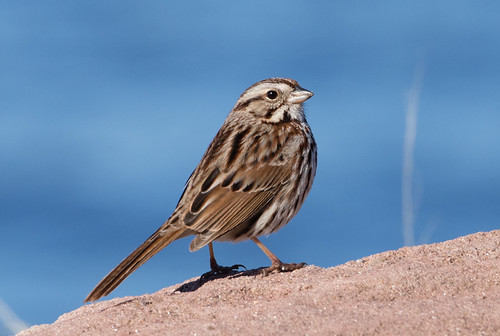 | |
|
The Song Sparrow is extremely important for even beginning birders to learn because it’s a common nesting backyard bird over much of North America, and it winters over most of the United States. Study its face as well as its breast streaks—the dark, blackish triangle on either side of the white throat (called a malar stripe), is an important field mark.
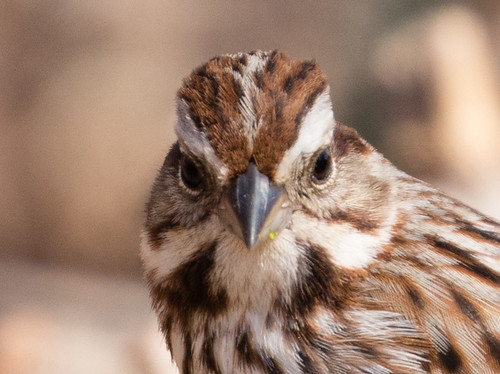 |
| Song Sparrow |
Unlike juncos and Fox Sparrows, one or two pairs of Song Sparrows will nest here on Peabody Street, so they’ll remain a conspicuous daily bird into October.
 |
| Lincoln's Sparrow |
Soon another sparrow with a streaked underside will also appear in my yard, at least a few times. Lincoln’s Sparrow shares that streaked underside with the central spot, but its streaks seem painted on by the finest brush or pencil while the Song Sparrow’s seem painted on with a much thicker brush.
 | |
|
Lincoln’s Sparrow is one of my favorites for its soft appearance. Its breast is buffier and its cheeks grayer than a Song Sparrow's, with a narrower malar stripe and a buffy submustachial marking rather than the dark, triangle of the Song Sparrow, and its throat is delicately streaked. Lincoln’s Sparrows nest in boggy areas up here, so most of us see them in our backyards only during migration.
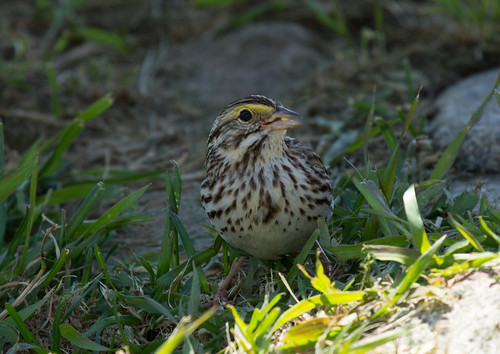 |
| Savannah Sparrow |
The other two sparrows with streaking are much less likely to be seen in most suburban-type backyards except rarely during migration, and then usually only during bad weather. If you spend any time birding in grasslands, the Savannah Sparrow is important to learn, but don’t count on seeing one in your yard. I’ve seen them in mine just once or twice in the 41 years I’ve lived here, during late snowfalls.
Most Savannah Sparrows have a noticeable yellow lore—the marking between the eye and bill—which may be bright or quite dull. If you see that yellow mark on a heavily streaked sparrow, it’s a Savannah, but the yellow can be subtle. The white throat on Savannah Sparrows is less conspicuous than that of Song Sparrows because it's often delicately streaked. Savannah Sparrows also have a pinker bill.
The Swamp Sparrow doesn’t have a heavily streaked breast in spring—many have few or no breast streaks at all—and it’s seldom seen at feeders except in terrible weather during migration. Most Swamp Sparrows have a rusty cap, and the wings and tail are fairly rusty, too, though darker—not as strikingly fox-colored as the Fox Sparrow.
Next time I’ll focus on the native American backyard sparrows that are usually unstreaked beneath.

